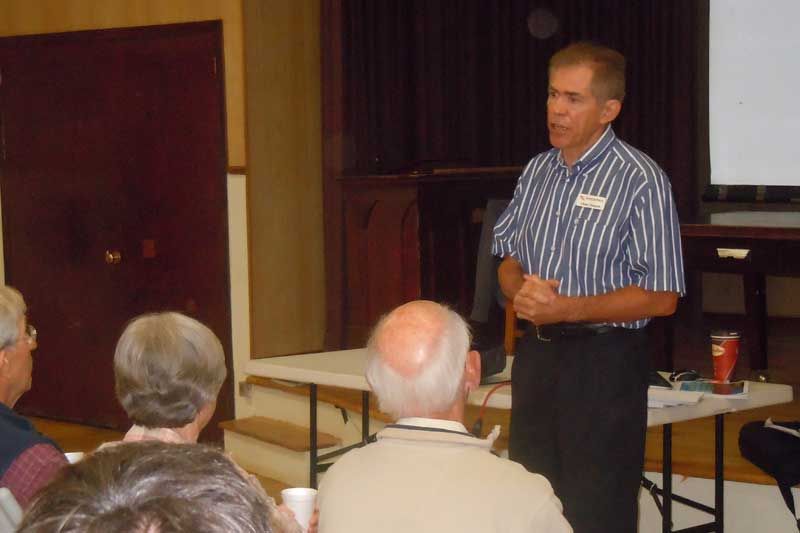Julie Druker | Sep 11, 2013
In an effort to raise public awareness about development on “at-capacity” lakes – i.e. ones that are labeled as highly sensitive lake trout lakes –the Township of Central Frontenac held a workshop on September 7 at Oso hall outlining exactly what those development guidelines are.
Township planner Glenn Tunnock headed up the meeting, which included a power point presentation, an examination of three fictional case studies of proposed developments or redevelopments, and a quiz for the 30 audience members who attended the workshop. Tunnock said that the purpose of the workshop was to ensure that people understand what the impacts of development are on these at-capacity lakes and how decisions made regarding development on them impact their water quality and shore lines. “If we raise public awareness, property owners will make better decisions regarding development and that is the key thing here,” he said.
There are four highly sensitive lake trout lakes in Central Frontenac: Crow, Eagle, and Silver lakes as well as the west basin of Sharbot Lake.
The guidelines in the township's zoning bylaw provides for a setback of 300 metres for new construction on these lakes.
Where the confusion can often occur is for those looking either to renovate or redevelop existing structures on these lakes.
The current Zoning By-law defines the term renovate as “strengthening, improving, retrofitting or restoring to a better state any aspect of an existing structure and it forbids the removal of more than 50% of the walls (or wall studs) of that existing building or structure.
Redevelopment is defined as “the removal or rehabilitation of buildings or structures and the construction, reconstruction or erection of other buildings or structures in their place”. Buildings on lots that do not meet current lake frontage and lot depth requirements are referred to as “non-conforming and non-complying uses” and construction on these lots must meet development requirements and setback standards for both the structure and the septic field. Any deviations require a minor variance and approval from the municipality.
Tunnock was quick to point out that the rules are not “black and white” and that knowledge and collaboration with township staff are the key to property owners being successful in meeting their goals.
“We want to collaborate and work with people because there is always more than one solution to a problem.. It is not necessarily black and white. Every property is different and there can be more than one solution. What we strive to do is to collaborate with people and together come to the solution that has the best merits for any one particular property.”
The presentation also highlighted some of the exceptions to the existing guidelines. For example, vacant lots having a lesser frontage and/or lot area than required in the Zoning By-law may be used for a purpose permitted for waterfront residential properties provided it can be adequately serviced with water and sewage services and has a minimum lot area 1,950 square metres (20,900 square feet). Similarly, alternatives to a septic tile bed are permitted, such as a composting or chemical toilet, as long as they are approved by the local Health Unit.
Regarding commercial development on these four at-capacity lakes, a hand-out from the township highlighted that applications for enterprises such as trailer parks, commercial cabin rentals, campgrounds or marine facilities would require rezoning and “would likely not be approved by the municipality.” Back shore (back lot) development is permitted provided that lake capacity exists. It can occur beyond the 300 metre zone and would also require municipal approval.
Tunnock’s presentation went into greater detail regarding specific rules and regulations and those present had many of their personal queries answered. Irv Dardick, who is the current president of the Eagle Lake Property Owners’ Association, was present at the workshop. He was also instrumental in making the workshop come about.
“It’s been obvious for years that property owners on these at-capacity lakes do not have a lot of information readily available to them on what they can do regarding renovations and redevelopment of their properties. The ministries came up with so little information at the beginning of all of this and although it was incorporated into the Official Plan and Zoning By-law, it was very difficult to access since it was spread out all over the place,” he said.
Dardick hopes to see the township hold more public workshops that inform the public of the most current guidelines regarding development on at-capacity lakes. “In the past there has been a lot of confusion and misconceptions about what you can and can’t do and that was the whole rationale for holding this kind of workshop,” he said.
More Stories
- Latest CUPW Job Action Stops Postal Delivery Of The Frontenac News Forcing Alternate Plans
- Opponents of Barbers Lake Gravel Pit Pack Ag Hall in McDonalds Corners
- Bobsleigh Olympian Jay Dearborn At Mikes Pizza In Sydenham
- The Loins Club Of and O'Lakes Roar
- North Frontenac Back Roads Studio Tour - September 27 and 28
- Sunday Market Vendors Give Back
- George Street Work As Town Hall Renovation Nears Completion
- One Way Street Plan Hits A Dead End - Central Frontenac Council, September 9
- Global Gardening
- No Winner Yet in Catch The Ace But Fundraising Target Met

